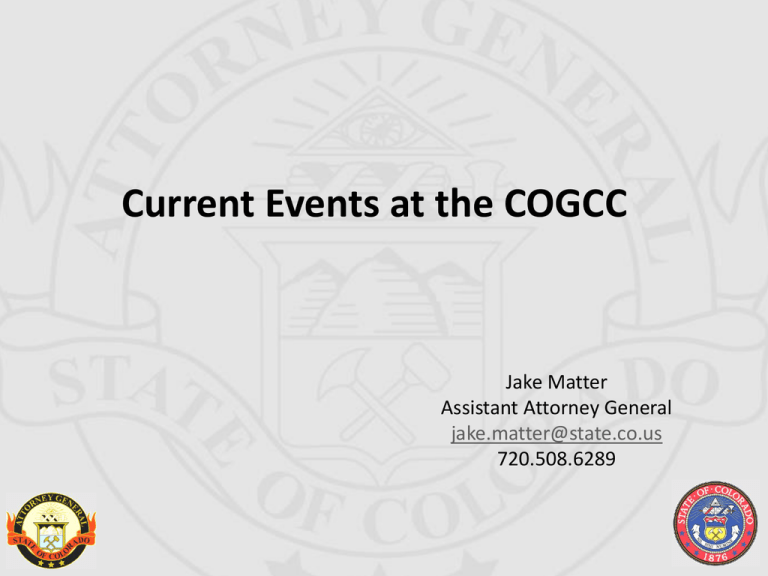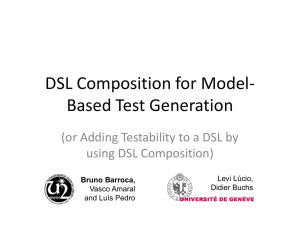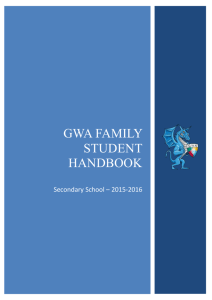Power Point
advertisement

Current Events at the COGCC Jake Matter Assistant Attorney General jake.matter@state.co.us 720.508.6289 1. New COGCC Water Sampling Rule 2. New COGCC Setbacks Rule 3. CDPHE Oil and Gas Stakeholder Group NEW WATER SAMPLING RULES Different rules for GWA • Greater Wattenberg Area, or “GWA” • GWA is an oil and gas field northeast of Denver encompassing 2,916 square miles • GWA accounts for 60% of oil produced in state • GWA has nearly 20,000 producing wells • Long history of production • Different treatment in rules Historic Water Sampling Requirements • • • • • 2000 – CBM wells in the San Juan Basin 2005 – GWA wells (infill wells only) 2009 – CBM wells statewide 2009 – Water sampling as a COA 2011 – GWA wells, not just infill wells Old GWA Water Sampling Rule • Baseline sample required where the first well was proposed in a governmental section • Hundreds previously collected • Domestic well in Laramie/Fox Hills Aquifer was highest priority • If no water well within ½ mile, no testing required • Sampling and reporting requirements • COGCC Rule 318A.e(4) New GWA Water Sampling Rule 1 source, 2 samples • Baseline sample required where the first well is proposed in a governmental quarter section • One follow-up sample (6-12 months post completion) • Amended COGCC Rule 318A.e(4) New Statewide Water Sampling Rule Up to 4 sources, 3 samples • Sample all sources within ½ mile of well, up to four • Baseline (within 12 months prior to drilling) • First follow-up sample (6-12 months postcompletion) • Second follow-up sample (5-6 years postcompletion) • New COGCC Rule 609 Similarities • • • • • • • • Apply to wells, multi-well sites and injection wells “Available” water sources No requirement to drill monitoring well “Piggybacking” No presumption of liability “Recommended” Sampling and Analysis Plan Not a limit on COGCC Director authority; COAs Notify well owner of thermogenic gas, or where methane levels increase or exceed thresholds NEW SETBACK RULES Purposes • Advance notice to impacted parties • Advise affected parties of how to participate in permitting process • Increase engagement among operator, surface owners and Local Governmental Designees (LGD) • Increase distances from homes and nuisances Old Setbacks Rules – The Numbers • Minimum – 150’ or 1.5 times height of derrick • High Occupancy Area (HOA) – 350’ New Setback Rules – The Numbers • Urban Mitigation Area – 500’ • Non Urban Mitigation Area – 500’ • Schools, hospitals, daycares etc. – 1,000’ New Setback Rules – The Effect • Heightened mitigation if well / facility would be within 1,000’ of a home. Rule 604.c. – Drilling noise limitation reduced from industrial (80/75 db) to light industrial (70/65 db) – Closed loop drilling systems – Green completions – Traffic plans – Use existing facilities and well bores – Berm construction – Fencing “Designated Setback Locations” (DSL) • If a proposed well falls within one of many enumerated DSLs, additional notification, consultation and operational requirements are triggered DSLs include: • High Occupancy Building Unit DSL. Is a hospital or school within 1,000’ of the proposed well? • Buffer Zone DSL. Is a home within 1,000’ of the proposed well? • Exception Zone DSL. Is a home within 500’ of the proposed well? High Occupancy Building Unit DSL • Full Commission must approve well within 1,000’ of a High Occupancy Building Unit • No staff-level approval • If Commission approves such a well, mitigation measures required for “Exception Zone DSLs” apply, including noise restrictions, closed loop drilling, green completions, steel rimmed containment berms Buffer Zone DSL • Homeowners within 1,000’ receive “Notice of Intent to Conduct Oil and Gas Operations” from operator 30 days prior to operator submitting application materials to COGCC – Operator and LGD contact information – Location, description, timing – Governor’s task force recommendation Buffer Zone DSL, continued • Homeowners within 1,000’ receive “Notice of Comment Period” • Sent after COGCC staff deems APD is complete • COGCC staff consider public comments in final approval of application • Operators must invite meetings with notified parties and hold such meetings if public or LGD requests • Public meetings to address security, nuisance impacts and mitigation measures Buffer Zone DSL, continued • No well will be approved if within 1,000’ of a home unless the COGCC permit contains sitespecific COAs “as necessary to eliminate, minimize or mitigate potential adverse impacts to public health, safety, welfare, the environment, and wildlife.” Rule 604(a)(2). • Rules are a floor and do not limit the Director’s ability to impose site-specific COAs Exception Zone DSL • Exception Zone DSL applies where the planned well is within 500’ of a home • All mitigation measures required under Buffer Zone DSL are required, plus other berm construction requirements, including steel rimmed containment berms and liners. Rule 604.c.(3). • Requires an exception from the COGCC Exception Zone DSL • Homeowners within 500’ receive “Notice of Intent to Conduct Oil and Gas Operations” from operator 30 days prior to operator submitting application materials to COGCC – Operator and LGD contact information – Location, description, timing – Governor’s task force recommendation Exception Zone DSL • Homeowners within 500’ receive OGLA notice upon completeness determination by COGCC – List of equipment to be used at site – Engineering drawings – Access map – Instructions on how to contact LGD and meet with operator – Invitation to provide written comments to COGCC – OGLA notice not required in GWA Exceptions to the 500’Setback • Exceptions may be granted by the Director • Director must report all exceptions to Commission monthly • Criteria for granting an exception differs depending on whether location is in a Urban Mitigation Area, or not UMA • Urban Mitigation Area (UMA) is a new term of art, but is a similar concept to the old High Occupancy Area (HOA) UMA is a lower threshold than HOA UMA HOA 22 homes / 1000’ Radius 36 homes / 1000’ Radius 11 homes / semicircle 18 homes / semicircle 1 home every 2 acres 1 home every 3.2 acres 1 school, hospital, nursing home etc. 1 school, hospital, nursing home etc. Waiver required if w/in 500’ of a home Waiver required if w/in 350’ of a home Exceptions inside / outside UMA • If inside UMA, waivers must be received from all property owners within Exception Zone / 500’ • If outside UMA, no waivers needed • If outside UMA, Director must insure that the COGCC permit contains site-specific COAs “sufficient to eliminate, minimize or mitigate potential adverse impacts to public health, safety, welfare, the environment, and wildlife to the maximum extent technically feasible and economically practicable.” Rule 604.a.(1).B. CDPHE APCD Oil and Gas Stakeholder Group Purposes • Discuss revisions to the Air Quality Control Commission’s Regulations Numbers 3, 6, 7, and Common Provisions. • Discuss full adoption of 40 CFR Part 60, Subpart OOOO (“NSPS OOOO”) • Discuss additional control measures for oil and gas operations and equipment. Timeline • December 27, 2012 – APCD announces stakeholder process • January 28, 2013 • February 28, 2013 • March 28, 2013 • April 25, 2013 • May 22, 2013 • All meetings at CDPHE Campus, Building A, Sabin Cleere Rooms March 28, 2013 Agenda • APCD will discuss comments received and any revisions made concerning the potential revisions to Regulations Numbers 3, 6, and 7. • APCD will discuss further potential revisions to Regulation Number 7 and the Common Provisions. Rulemaking Process Goal • August 2013 Request for Hearing • November 2013 Hearing Rules under consideration would: • Go “well beyond existing federal and state requirements” • Reduce VOCs, methane and other pollutants. • Focus on reducing fugitive emissions and leaks from large emissions sources, i.e., condensate tanks • Find and fix leaks via infrared cameras or other technologies – Denver Post Guest Commentary, March 13, 2013, Dr. Chris Urbina and William C. Allison of CDPHE. Questions? Jake Matter 303.866.5041 Jake.matter@state.co.us









